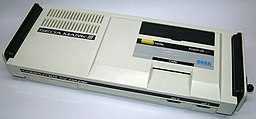SG-1000
 | |
| Manufacturer | Sega |
|---|---|
| Type | Video game console |
| Generation | Second generation |
| Lifespan | |
| Media | Cartridge |
| CPU | NEC 780C (clone of Zilog Z80) |
| Successor | Sega SG-1000 Mark III |
The SG-1000 (エスジー・セン, Esujī Sen), which stands for Sega Game 1000, is a cartridge-based video game console manufactured by Sega. This system marked Sega's entry into the home video game hardware business, which they would continue to be in until the end of the Dreamcast in 2001. While the system was not very popular, it was the basis for the more successful Sega Master System.
History
It was test marketed in Japan in 1981 and first released to the Japanese market in July 1983 for ¥15,000. The console reached minor success in that market. The system sold well within Asia until 1985, in New Zealand as released by Grandstand Leisure Limited, and in other countries, such as Italy, Spain, and South Africa. The console in its original form never reached North America.
Game manufacturer Tsukada Original made Othello Multivision, an SG-1000 clone. Bit Corp's Dina 2-in-1 ColecoVision clone was brought to North America by a company called Telegames. Telegames called its clone the Telegames Personal Arcade, which could play ColecoVision and SG-1000 games.

A caveat is the SG-1000's surprisingly wide availability on Taiwan's secondary market. This console is highly significant in Taiwan as one of its first and best-remembered consoles, where it was manufactured and sold (very briskly) under license as "阿羅士". This was striking in that in the same time period from 1981 to 1986, Famicom games were widely pirated as standalone and multi-carts (replete with rudimentary switch banks to select the active ROM), as well as no less than three different pirated versions of the Atari 2600 with boastful monikers characteristic of the times ("冒險家" ('Adventurer'), "賓果" ('Delight'), "強棒創造者" ('Steadfast Creator')).
Taiwan, among a few other countries, also received a "Mark IV" version of the console (most likely a modified Sega Master System II) and the Mark naming convention was further extended to the Mega Drive/Genesis ('Mark V').
Availability
The SG-1000 is an extremely rare and sought after console, and has been known to be sold at hefty prices at an upwards of $300 for a used one, on various auction sites, such as Ebay.
Emulation
The Gametap subscription gaming service includes an emulator of the SG-1000 console. As of June 15, 2007, eleven SG-1000 titles were available for play.
The open source emulators blueMSX and MEKA emulate among other platforms, the SG-1000 console.
SG-1000 Mark II
In July 1984, Sega released an updated version of the console called the SG-1000 Mark II. It is functionally identical to the Mark I, but has a re-styled shell and the connector for the optional plug-in SK-1100 keyboard has been moved from the rear to the front. It was initially priced at ¥15,000. A computer version of this console, with a built-in keyboard, was called the SC-3000, which would go on to outsell the SG-1000.
The SG-1000 runs all SC-3000 games and applications, with the exception of Music and Basic Cartridges. The machine could be used just like the SC-3000, provided one had the keyboard attachment ready. The console also had an optional game card reader add-on called the Card Catcher that allowed for the use of Sega game card software.
The Card Catcher would become built into the SG-1000 Mark III, as well as the first version of the Sega Master System.
SG-1000 Mark III
 The SG-1000 Mark III, a yet newer version in Japan with improved video hardware and an increased amount of RAM, would be redesigned to become the Sega Master System.
The SG-1000 Mark III, a yet newer version in Japan with improved video hardware and an increased amount of RAM, would be redesigned to become the Sega Master System.
Specifications
- CPU: NEC 780C (clone of Zilog Z80)
- 3.579545MHz for NTSC, 3.546893MHz for PAL
- Main RAM: 16 kbit (2 kB)
- Video RAM: 128 kbit (16 kB)
- Sound: Texas Instruments SN76489
- 4-channel mono sound
- 3 sound generators, 4 octaves each, 1 white noise generator
- Video processor: Texas Instruments TMS9928A
- 256x192 resolution
- 32 sprites
- 16 colors
